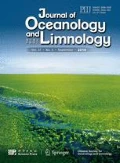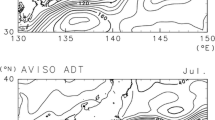Abstract
Using hydrographic data sampled during four successive late summer-early autumn cruises in 2004–2007, vertical stratification along transects in the lee of Taiwan Island was analyzed to investigate upper ocean responses to orographically induced dipole wind stress curl (WSC). Results indicate that mixed-layer depth (MLD) and its relationship with thermocline depth varied under different local wind forcings. Average MLD along the transects from the 2004 to 2007 cruises were 18.5, 30.7, 39.2 and 24.5 m, respectively. The MLD along the transects deepened remarkably and resulted in thermocline ventilation in 2005 and 2006, whereas ventilation did not occur in 2004 and 2007. Estimates indicate that frictional wind speed was the major factor in MLD variations. To a large degree, the combined effects of frictional wind speed and Ekman pumping are responsible for the spatial pattern of MLD during the cruises.
Similar content being viewed by others
References
Du Y. 2002. Seasonal dynamics of the mixed layer and thermocline in the South China Sea, Ph.D. dissertation, Ocean Univ. of China, Qingdao. 240p.
Fairall C W, Bradley E, Rogers D P, Edison P J B, Young G S. 1996. Bulk parameterization of the air-sea fl uxes for tropical ocean-global atmosphere coupled-ocean response experiment. Geophys. Res. Lett., 101: 3 747–3 764.
Fang W, Fang G, Shi P, Huang Q, Xie Q. 2002. Seasonal structures of upper layer circulation in the southern South China Sea from in situ observations. J. Geophys. Res., 107: 3 202, http://dx.doi.org/10.1029/2002JC001343.
Jia Y, Liu Q, Liu W. 2005. Primary study of the mechanism of eddy shedding from the Kuroshio Bend in Luzon Strait. J. Oceanogr., 61: 1 017–1 027.
Kara A B, Rochford P A, Hurlburt H E. 2000. Mixed layer depth variability and barrier layer formation over the North Pacific Ocean. J. Geophys. Res., 105(C7): 16 783–16 802.
Kraus E B, Turner J S. 1967. A one-dimensional model of the seasonal thermocline. Part II: The general theory and its consequences. Tellus, 19: 98–105.
Liu Q, Jia Y, Liu P, Wang Q. 2001. Seasonal and interseasonal thermocline variability in the central South China Sea. Geophys. Res. Lett., 28(23): 2 267–4 470.
Liu W T. 2002. Progress in scatterometer application. J. Oceanogr., 58: 121–136, http://dx.doi.org/10.1023/A:1015832919110
Liu W T, Xie X. 1999. Space-based observations of the seasonal changes of South Asian monsoons and oceanic response. Geophys. Res. Lett., 26: 1 473–1 476.
Luis A J, Kawamura H. 2004. Air-sea interaction, coastal circulation and primary production in the eastern Arabian Sea: a review. J. Oceanogr., 60: 205–218.
Martin R, Moore G W K. 2007. Air-sea interaction associated with a Greenland reverse tip jet. Geophys. Res. Lett., 34, L24802, http://dx.doi.org/10.1029/2007GL031093.
Monterey G, Levitus S. 1997. Seasonal variability of mixed layer depth for the World Ocean. NOAA Atlas NESDIS 14, U.S. Gov. Printing Office, Wash. DC. 100p.
Pickart R S, Spall M A, Ribergaard M H, Moore G W K, Milliff R F. 2003. Deep convection in the Irminger Sea forced by the Greenland tip jet. Nature, 424(6945): 152–156.
Qu T. 2001. The role of ocean dynamics in determining the mean seasonal cycle of the South China Sea surface temperature. J. Geophys. Res., 106: 6 943–6 955.
Qu T, Du Y, Gan J, Wang D. 2007. Mean seasonal cycle of isothermal depth in the South China Sea. J. Geophys. Res., 112: C02020, http://dx.doi.org/10.1029/2006JC003583.
Shaw P-T. 1991. Seasonal variation of the intrusion of the Philippine Sea water into the South China Sea. J. Geophys. Res., 96: 821–827.
Wang B, Wu R, Fu X. 2000. Pacific-East Asian teleconnection: how does ENSO affect East Asian climate? J. Clim., 13: 1 517–1 536.
Wang D, Liu Y, Qi Y, Shi P. 2001a. Seasonal variability of thermal fronts in the northern South China Sea from satellite data. Geophys. Res. Lett., 28(20): 3 963–3 966.
Wang D, Du Y, Shi P. 2001b. Evidence for thermocline ventilation in the South China in winter, Chin. Sci. Bull., 46(9): 774–778.
Wang G, Chen D, Su J. 2008. Winter eddy genesis in the eastern South China Sea due to orographic wind jets. J. Phys. Oceanogr., 38: 726–732.
Wu C-R, Chiang T L. 2007. Mesoscale eddies in the northern South China Sea. Deep Sea Res., Part II, 54: 1 575–1 588.
Xie S-P, Liu W T, Liu Q, Nonaka M. 2001. Far-reaching effects of the Hawaiian Island on the Pacific Ocean-Atmosphere. Science, 292: 2 057–2 060.
Xie S-P, Xie Q, Wang D, Liu W T. 2003. Summer upwelling in the South China Sea and its role in regional climate variations. J. Geophys. Res., 108: 3 261, http://dx.doi.org/10.1029/2003JC001867.
Xu H, Xie S-P, Wang Y, Zhuang W, Wang D. 2008. Orographic effects on South China Sea summer climate. Meteorol. Atmos. Phys., 100: 275–289.
Yuan D, Han W, Hu D. 2006. Surface Kuroshio path in the Luzon Strait area derived from satellite remote sensing data. J. Geophys. Res., 111: C11007, http://dx.doi.org/10.1029/2005JC003412.
Yuan D, Han W, Hu D. 2007. Anti-cyclonic eddies northwest of Luzon in summer-fall by satellite altimeters. Geophys. Res. Lett., 34: L13610, http://dx.doi.org/10.1029/2007GL029401.
Zhang Y. 1997. East Asian winter monsoons: results from eight AMIP models. Clim. Dyn., 1 3: 11 797–11 820.
Zhuang W, Xie S P, Wang D, Taguchi B, Aiki H, Sasaki H. 2010. Intraseasonal variability in sea surface height over the South China Sea. J. Geophys. Res., 115: C04010, http://dx.doi.org/10.1029/2009JC005647.
Author information
Authors and Affiliations
Corresponding author
Additional information
Supported by the Knowledge Innovation Program of Chinese Academy of Sciences (No. KZCX2-YW-Q11-02), the National Basic Research Program of China (973 Program) (No. 2011CB403503), and the National Natural Science Foundation of China (Nos. 40876009, 41176028)
Rights and permissions
About this article
Cite this article
Deng, Y., Shi, P., Zhou, W. et al. A dipole wind curl pattern induced by Taiwan Island and its effect on upper stratification in the northeastern South China Sea. Chin. J. Ocean. Limnol. 30, 944–952 (2012). https://doi.org/10.1007/s00343-012-1260-2
Received:
Accepted:
Published:
Issue Date:
DOI: https://doi.org/10.1007/s00343-012-1260-2




